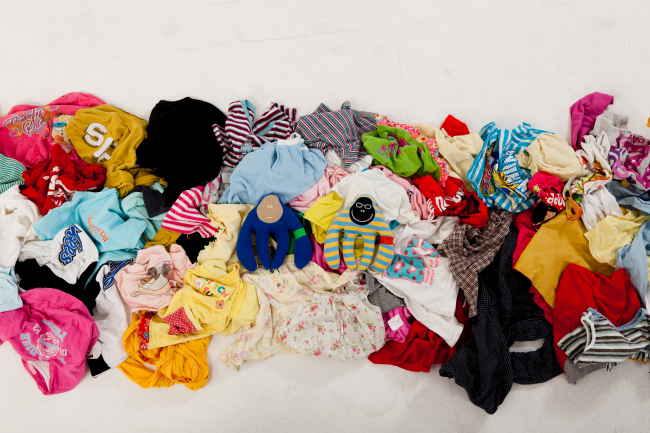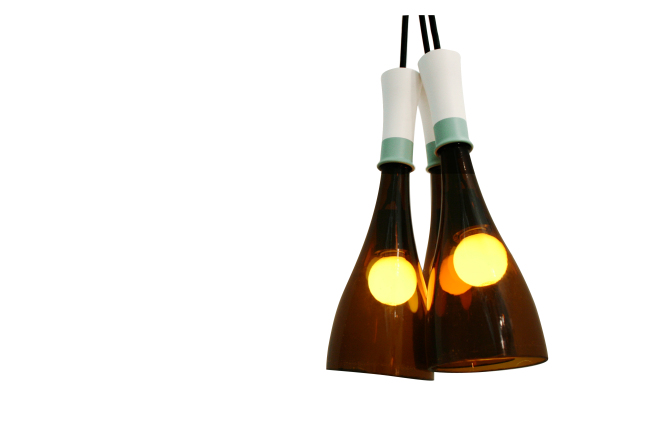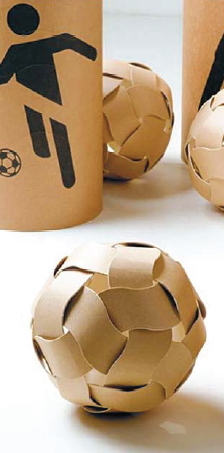Junk reborn as art
Designers combine aesthetics, creativity and environmental awareness to give new life to waste materials
By Korea HeraldPublished : Oct. 3, 2013 - 20:19

This is the seventh installment in an eight-part series that examines the social role of design beyond its aesthetic aspect. The weekly series is a precursor to Herald Design Week 2013, Oct. 7-11, which is organized under the theme “Re-imagine the World.” — Ed.
From a biodegradable meal tray to sculptures made of tires, design products and artwork from recyclable materials are becoming part of everyday life around the world.
The movement has also become active here in recent years, as an increasing number of innovators are using their creativity on cast-off things, inspiring people to question the culture of mass production and its irreversible impact on the environment.
“Recycled design or art has evolved quickly in Korea with a growing number of people concerned about the consume-and-discard nature of the mass production culture today,” said Kim Jae-myeong, art professor at Kyungsung University and former director of the Design Center Busan.
“The demand for well-made recycled design products is growing. Not only designers but also businesses are moving fast to satisfy this changing consumer behavior,” he said.
Recycled or junk art, however, is not just about turning waste products into art, but also an effective way to promote green awareness through the power of design, experts say.
“Recycling trash and transforming it into art is an amazing aesthetic experience. It is like finding treasure in a desert,” said Yoon Ho-seob, honorary professor at Kookmin University’s Graduate College of Green Design.
“The ultimate goal of recycled art, however, is to make people keep the environment clean and pursue a sustainable future,” he said.
Recycled art emerged two decades ago when nations reached an agreement to make a concerted effort to fight against global warming. A United Nations meeting held in Rio de Janeiro in 1992 brought a paradigm shift worldwide toward sustainable development, inspiring artists around the world.
Manontanto, an Incheon-based design studio, turned to recycled design in 2006. Its “Relight” project (2009) showcased a series of recycled artworks that carried humorous, whimsical and inspiring ideas.
From a biodegradable meal tray to sculptures made of tires, design products and artwork from recyclable materials are becoming part of everyday life around the world.
The movement has also become active here in recent years, as an increasing number of innovators are using their creativity on cast-off things, inspiring people to question the culture of mass production and its irreversible impact on the environment.
“Recycled design or art has evolved quickly in Korea with a growing number of people concerned about the consume-and-discard nature of the mass production culture today,” said Kim Jae-myeong, art professor at Kyungsung University and former director of the Design Center Busan.
“The demand for well-made recycled design products is growing. Not only designers but also businesses are moving fast to satisfy this changing consumer behavior,” he said.
Recycled or junk art, however, is not just about turning waste products into art, but also an effective way to promote green awareness through the power of design, experts say.
“Recycling trash and transforming it into art is an amazing aesthetic experience. It is like finding treasure in a desert,” said Yoon Ho-seob, honorary professor at Kookmin University’s Graduate College of Green Design.
“The ultimate goal of recycled art, however, is to make people keep the environment clean and pursue a sustainable future,” he said.
Recycled art emerged two decades ago when nations reached an agreement to make a concerted effort to fight against global warming. A United Nations meeting held in Rio de Janeiro in 1992 brought a paradigm shift worldwide toward sustainable development, inspiring artists around the world.
Manontanto, an Incheon-based design studio, turned to recycled design in 2006. Its “Relight” project (2009) showcased a series of recycled artworks that carried humorous, whimsical and inspiring ideas.

Bottles once used to hold traditional liquor were turned into a modern light pendant while a cheap, steel-legged chair became an edgy, aesthetic candleholder in the hands of these designers.
“We became deeply attracted to (the field of) redesign because it added a new, pleasurable and fun twist to old, used materials and transformed them into completely new forms of art,” said Wang Jung-ah, designer director at Manontanto.
“Redesign projects have motivated us and pushed us to have more creative and fresh thinking,” she said.
Some recycled design works have gained international attention.
Eco Party Mearry, a design brand under Beautiful Store, a second-hand shop in Seoul, showcased its recycled design products at the Museum of Modern Art in New York. The brand was invited to MOMA’s gift shop in SoHo in 2009, for its creativity and innovative ideas in selecting recycled materials, the team said.
Its signature design is Mr. Rilla, made of used children’s T-shirts.
“The gorilla plush doll which resembles a highland mountain gorilla was designed to increase awareness of the endangered animals. Its special story must have touched people’s hearts,” a designer said.
An eco-friendly bag made from old banners and leather sofas was also popular, she said.
“We became deeply attracted to (the field of) redesign because it added a new, pleasurable and fun twist to old, used materials and transformed them into completely new forms of art,” said Wang Jung-ah, designer director at Manontanto.
“Redesign projects have motivated us and pushed us to have more creative and fresh thinking,” she said.
Some recycled design works have gained international attention.
Eco Party Mearry, a design brand under Beautiful Store, a second-hand shop in Seoul, showcased its recycled design products at the Museum of Modern Art in New York. The brand was invited to MOMA’s gift shop in SoHo in 2009, for its creativity and innovative ideas in selecting recycled materials, the team said.
Its signature design is Mr. Rilla, made of used children’s T-shirts.
“The gorilla plush doll which resembles a highland mountain gorilla was designed to increase awareness of the endangered animals. Its special story must have touched people’s hearts,” a designer said.
An eco-friendly bag made from old banners and leather sofas was also popular, she said.

Another design studio in Korea came up with aid packages that can be recycled into footballs by children in developing countries. The cylindrical container has patterns on the surface that allow it to be torn up and reassembled as a paper soccer ball. Titled Dream Ball, the eco-friendly design captured audiences in Europe, becoming an example of how inventive design can serve a greater purpose.
“To children in developing countries, having a football means a lot and can be the dream and hope for escape from their poor lives. However, they cannot buy a ball so they play football with a ball made of plastic bags, coconut palm leaves,” designers said.
“The aim of this project was to give them their own football,” they added.
To expand the idea of protecting the environment through art, Yoon of Kookmin University stressed the need to develop education programs on recycled art.
The artist has been running the Green Canvas project to encourage both professional and amateur designers to create art pieces out of recyclable materials and to learn about how to keep the environment clean in the process.
He holds the Green Summer exhibition every year as part of the project participated in by people of all generations from elementary school students to the elderly, he said. A group of 10-year-old students was the youngest in this year’s event, displaying a snowman made out of tape taken from delivery boxes.
“I believe we can bring small but profound changes in our lives by sharing the idea of recycled art with the people,” he said.
By Cho Chung-un (christory@heraldcorp.com)
“To children in developing countries, having a football means a lot and can be the dream and hope for escape from their poor lives. However, they cannot buy a ball so they play football with a ball made of plastic bags, coconut palm leaves,” designers said.
“The aim of this project was to give them their own football,” they added.
To expand the idea of protecting the environment through art, Yoon of Kookmin University stressed the need to develop education programs on recycled art.
The artist has been running the Green Canvas project to encourage both professional and amateur designers to create art pieces out of recyclable materials and to learn about how to keep the environment clean in the process.
He holds the Green Summer exhibition every year as part of the project participated in by people of all generations from elementary school students to the elderly, he said. A group of 10-year-old students was the youngest in this year’s event, displaying a snowman made out of tape taken from delivery boxes.
“I believe we can bring small but profound changes in our lives by sharing the idea of recycled art with the people,” he said.
By Cho Chung-un (christory@heraldcorp.com)
-
Articles by Korea Herald











![[KH Explains] How should Korea adjust its trade defenses against Chinese EVs?](http://res.heraldm.com/phpwas/restmb_idxmake.php?idx=644&simg=/content/image/2024/04/15/20240415050562_0.jpg&u=20240415144419)







